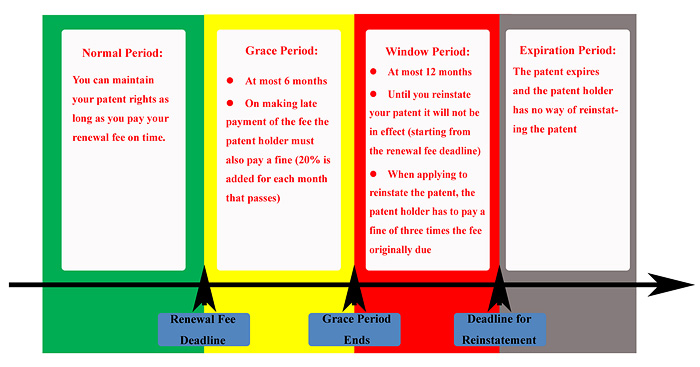
Recently intellectual property authorities in Indonesia have begun enforcing a rule which means that if no formal letter of abandonment of patent rights is received, payments for the three-year grace period of non-payment of annuities are being billed to patent holders even if they wished to abandon the patent; Meanwhile patent authorities in the Cayman islands have stopped allowing advance payment of renewal fees before the year they are due. All this suggests that a hitch in your company’s international patent management workflow will mean you have to put in a lot of effort to repair it, and if it is very serious, it may even have a negative impact on your company’s research and development and sales.
Michael is the general counsel of a tech company, this morning there are two letters on his desk. One of the letters is from the Japan Patent Office informing him that the rights to an invention patent his company was granted have been extinguished because the maintenance fees were not deposited before the end of the grace period. The letter states that if the company wishes to reinstate the patent they will have to pay a fine and file a petition; the other letter is from a major US client, stating that they wish to engage in cross-licensing negotiations. What is troubling is that the first patent on the list provided by the US client is the extinguished patent…
Maybe this specific situation has never happened to your company, but the extinguishing of patent rights is a risk that every company runs. Unfortunately most companies don’t have a proper understanding of the real risks of improper patent management workflow. If you belong to a big firm, on hearing about a lapse in renewal payments you might think “Sure, you have to pay to maintain patents anyway, so what is another fine on top of that?” If you are at a smaller firm, you are probably having trouble with even formulating a patent database and management mechanism, not even to mention establishing system of workflow.
The Four Big Risks of not Paying Renewals Promptly
Whatever the scale of your company, it is imperative that you have a correct grasp of patent management. Although patents do not create value directly, they are a bridge connecting technological skill and market profits, just like the Panama Canal, essentially just a waterway allowing container ships to navigate its length; as it links the Atlantic and Pacific Oceans, however, it has become essential to global trade. If something suddenly were to happen to the Panama Canal, it would mean that shipping costs between production bases and the markets where goods are sold would rise, affecting the global economy.
If there is a problem with patent management workflow, what are the consequences? To take Taiwan as an example, if you don’t pay your renewal fees before the deadline, the patent holder will face four main risks (See Figure 1):
- In Taiwan, when you enter the grace period, the patent holder has to pay at least an additional 20% on top of the original fee and a maximum of two times the fine for late payment. The fine for late payment will increase with the time it goes unpaid, which is a substantial financial burden on the patent holder.
- During the grace period and the window period, there is a risk of infringement occurring. When the grace period expires the Intellectual Property Office will announce the extinguishing of the patent rights (when it is reinstated successfully this is also announced), and if, in this period of time, other parties use the invention, the patent holder is unable to assert his rights, in accordance with Article 59 of the Patent Act. (Note 1).
- If you want to reinstate a patent during the window period, in addition to paying a fine at a rate of three times the renewal fee, you also need to send a petition to the Intellectual Property Office. The Taiwan Intellectual Property Office has already simplified procedures, shortening the length of time from application to reinstatement to around 22 working days, however, not all countries have these kinds of window period regulations, so the process for reinstating a patent is different everywhere, which is yet another cost that the patent holder has to worry about.
- If you are unsuccessful in your bid to reinstate your patent, the patent will become invalid, which is a loss you cannot recoup.
Figure 1. What happens when you don’t pay your renewal fees? (Taiwan as an example case)

Information courtesy of the Taiwan Intellectual Property Office; Diagram by Clarence Chiang
There is a common myth about patents suggesting that they take up only a miniscule amount of a legal department’s time. For any company, technological innovation and developing markets are much more important than getting an understanding of the complexities of the patent legislation of countries around the world; but we often forget that without patent rights, products are left unprotected and research and development can be seriously affected. In other words, even if a company invests a large amount of resources into research and development or into sales in a certain market, if there is a problem with patent management workflow, they may risk losing their patent rights and the technology that they have worked hard to research and develop will be available to third parties to use free of charge, so they lose out on all fronts. Therefore, do not think that patents have nothing to do with your job, as they are important for every department in a company.
PVIGO Insight: Prevention is Better than Cure
The best and simplest way to avoid problems in your patent renewals workflow is to pay renewal fees on time, but given that each country has different rules as to when payments must be made, in practice one needs the assistance of an agency for this. Do not think, however, that once you have outsourced patent renewals to an outside agency you are sitting pretty. To ensure there is no hold up in patent management workflow, there are several things the patent holder must do themselves:
- Establish a patent management system for your company: Companies need to have a comprehensive mechanism in place to evaluate whether or not to maintain each specific patent, which should extend to examining its market value, its technological value, the maintenance costs, and so on. In other words, instead of closely guarding every patent in their portfolio, it is prudent for companies to regularly assess the value of their patents in order to get the most out of their patent portfolio.
- Be careful when picking a renewals agency: Good renewals agencies must fulfill two important criteria: they must provide clients with timely reminders of deadlines for renewal payments and provide clients with data on their patents to help them with their patent strategy. With the PVIGO platform the patent holder can schedule reminders themselves, as well as monitoring the payment process, checking the deadlines for payments, the dates when future payments will be due and account information online. We also publish the pricing and schedule of renewal payments in different countries around the world, to assist the patent holder in formulating their patent strategy.
- Be sure to leave time for international transactions: Normally international renewal payments have to be made through agencies overseas. Patent holders should give direction on payment around a month (20 working days) before the deadline, to allow overseas agencies plenty of time to make payment.
Notes:
- The seventh limit on patent rights as stated in Article 59 of the Taiwan Patent Act: “[…] where, after an invention patent is extinguished pursuant to Subparagraph 3, Paragraph 1 of Article 70 and before it is reinstated and published pursuant to Paragraph 2 of Article 70, acts done by a person who has been exploiting the invention or making all the necessary preparations to do such an act in good faith […]”
Learn more about NAIP’s Patent Renewal Services
 |
|
| Author: |
Clarence Chiang |
| Current Post: |
Senior Editor, NAIP Newsletter |
| Education: |
Business Administration, National Chengchi University, Taiwan |
| Experience: |
Reporter, CommonWealth Magazine
Reporter, Business Today Magazine |
|
|
 |
|
| Author: |
Conor Stuart |
| Current Post: |
Senior Editor, IP Observer |
| Education: |
MA Taiwanese Literature, National Taiwan University
BA Chinese and Spanish, Leeds University, UK |
| Experience: |
Translator/Editor, Want China Times
Editor, Erenlai Magazine |
|
|
|
| Facebook |
|
Follow the IP Observer on our FB Page |
|
|
|
|
|
|



